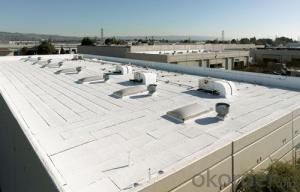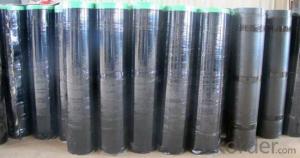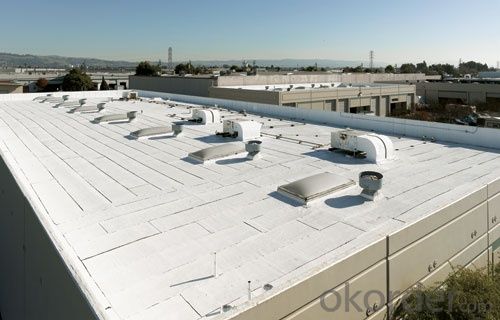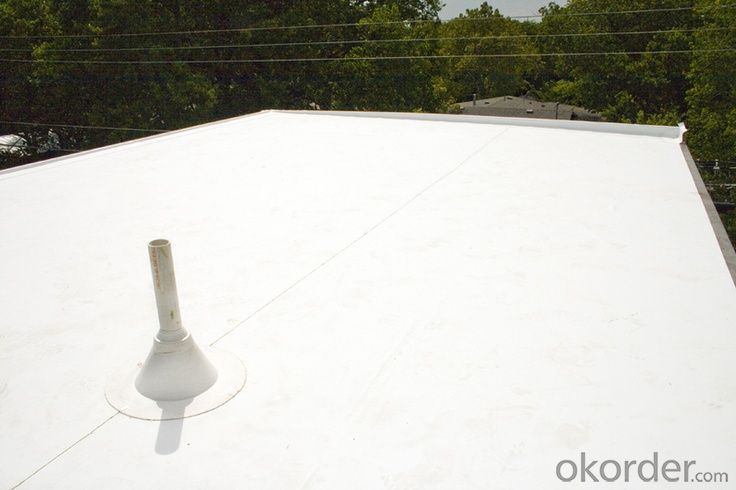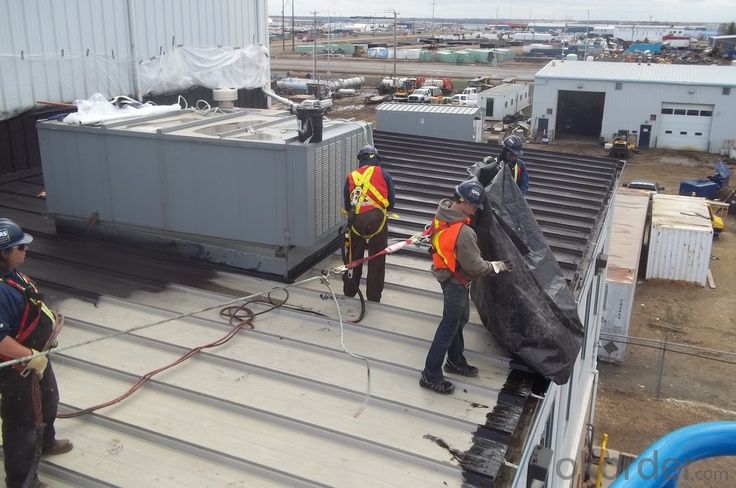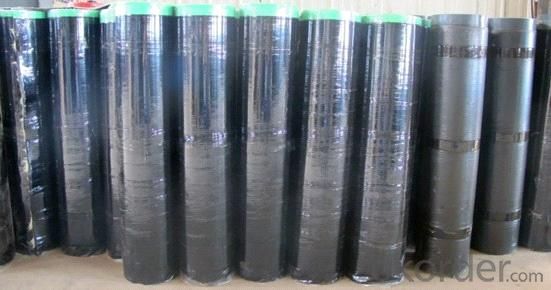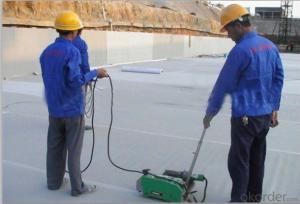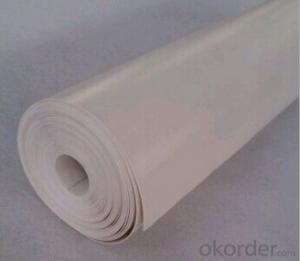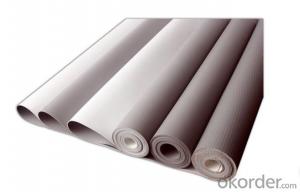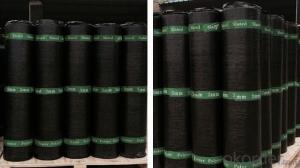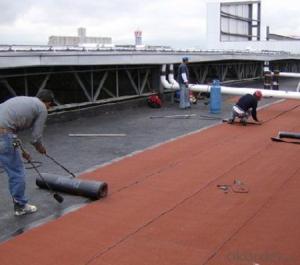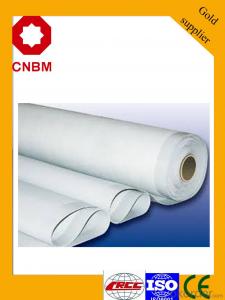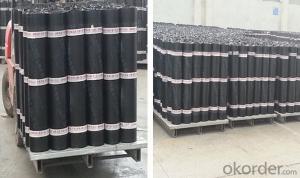SBS Waterproof Membrane, APP Waterproof Membrane, Asphalt Waterproof Membrane
- Loading Port:
- Shanghai
- Payment Terms:
- TT or LC
- Min Order Qty:
- 1000 m²
- Supply Capability:
- 200000 m²/month
OKorder Service Pledge
OKorder Financial Service
You Might Also Like
Product description
Specification | |
Width | 1m |
Length / roll | 7.5m / 10m / 15m or other |
Top Surface | PE film/Granules/Sand/Aluminum foil/Aluminum film... |
Apply method | a) One way is by heating and melting method.Heat the polyethylene film of the membrane and roof deck surface by heating and melting method to be nearly melted (not flowing),then install the membrane filly bonded to the roof deck with overlaps of 5-10cm. b) The other way is by cold adhesive method.Pour the cold adhesive homogeneously on the roof deck, then roll the membrane to install it to be fully sticked to roof deck. application as requested. c)After application,a full serious inspection is required to sure no air bubble, no falling away.etc. to guarantee the waterproof life. SBS waterproof membrane / APP waterproof membrane / Asphalt waterproof membrane for building waterproofing construction |
Construction Requirement | 1.The base should be dry and clean. Do not work in the rainy or snowy day. 2.Do not work under heavy wind(above 5 grade) 3.Unsuitable for construction below 5°C 4.If it is rain or snow in the process of construction, protective measure to the laid membrane is must. 5.All the workers should put on special uniforms to keep safe when installing. There should be equipments for fire controls. |
Packaging & Shipping
Package and transportation-- SBS waterproof membrane / APP waterproof membrane / Asphalt waterproof membrane for building waterproofing construction :
1. Torch on bitumen membrane sheets 4mm should be stored under dry and ventilated conditions.
2. Different types of membranes must be piled separately.
3. Under usual condition, storage period is one year since production date.
4. Membrane roll should be put vertically during transportation. It should be kept away from sunshine and rainwater.
.
Advantagee
1.Excellent anti aging performance ,service life up to 50 years.
2.High extension rate,high tensile strength ,small size changes at heat treatment.
3.Good plant roots penetrability resistance and can be made waterproofing layer of planting roof.
4.Special modified molecular structure ,effectively resolving the current domestic and foreign glue joint problem.
5.Good low temperature flexibility ,and good performance of adapting to ambient temperature changes.
6.Convenient application ,solid joint ,no environment pollution.
7.Chemical corrosion resistance ,can be used for special occasions.
8.Good anti-perforated.
Storage:
Different types or specifications of products should be separated, not mixed.
Keep it dry and ventilated, protected from the sun or rain.
Storage temperature should never be higher than 45 °C. Pile up the membranes flatwise whose stockpile height never exceeds five layers. One layer is guaranteed if it is placed vertically.
Prevent it from inclination or In the process of transportation, it should be lying in case of inclination or lateral pressure. If necessary, cover it with felt-cloth.
Storage time is at least one year from manufacture date on if the product is under normal operation of storage.
Technical Parameters
Item | Index | ||||||
1 | Thickness of resin layer of the middle fabric ,mm≥ | - | - | 0.40 | 0.40 | 0.40 | |
2 | Tensile performance | Max tensile strength,N/cm ≥ | - | 120 | 250 | - | 120 |
Tensile strength,NPa ≥ | 10 | - | -10 | - | - | ||
Max elongation% ≥ | - | - | 15 | - | - | ||
Breaking elongation % ≥ | 200 | 150 | - | 200 | 100 | ||
3 | Heat treatment size change rate%≤ | 2.0 | 1.0 | 0.5 | 0.1 | 0.1 | |
4 | Cold bonding | -25°c No cracks | |||||
5 | Watertightness | 0.3mPa,2h waterproof | |||||
product show
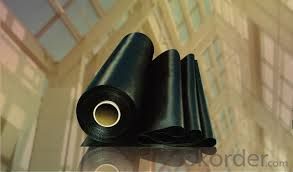
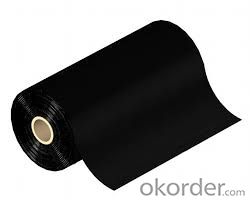
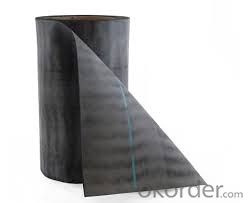
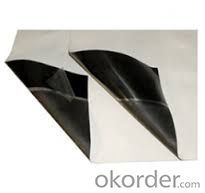
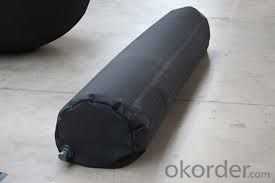
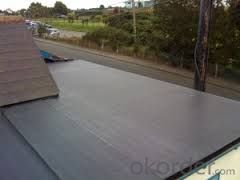
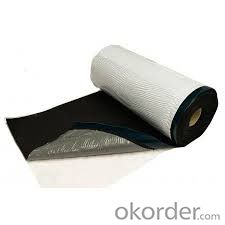

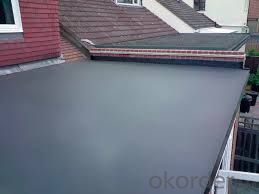
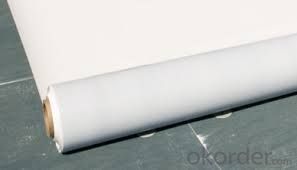
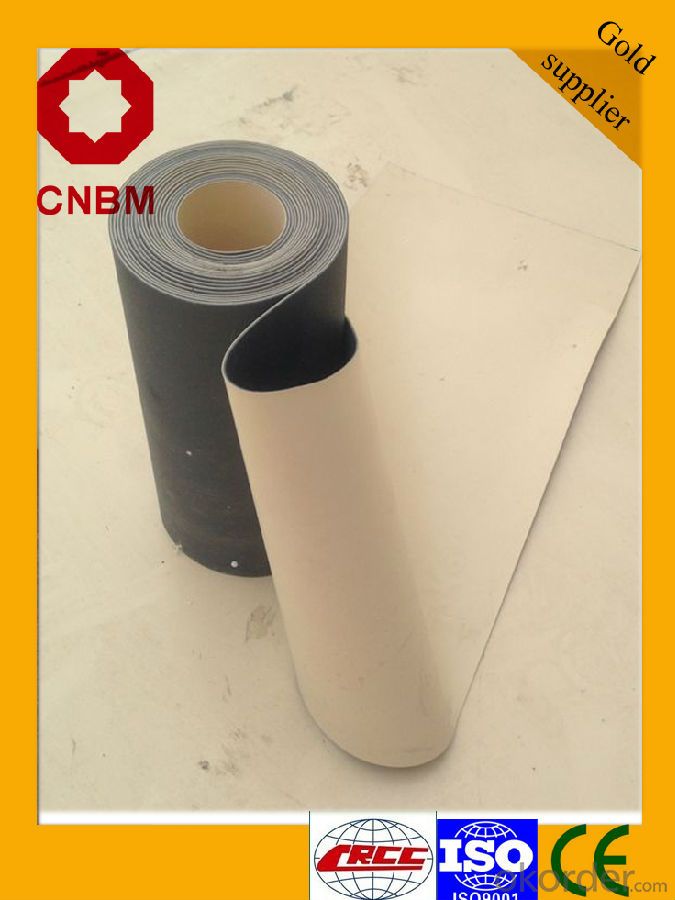

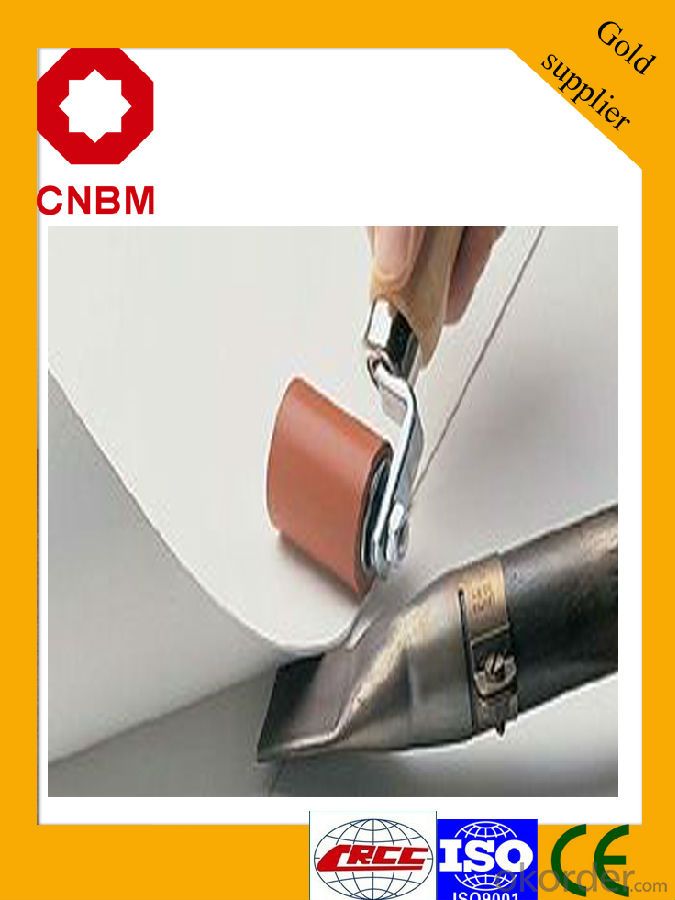
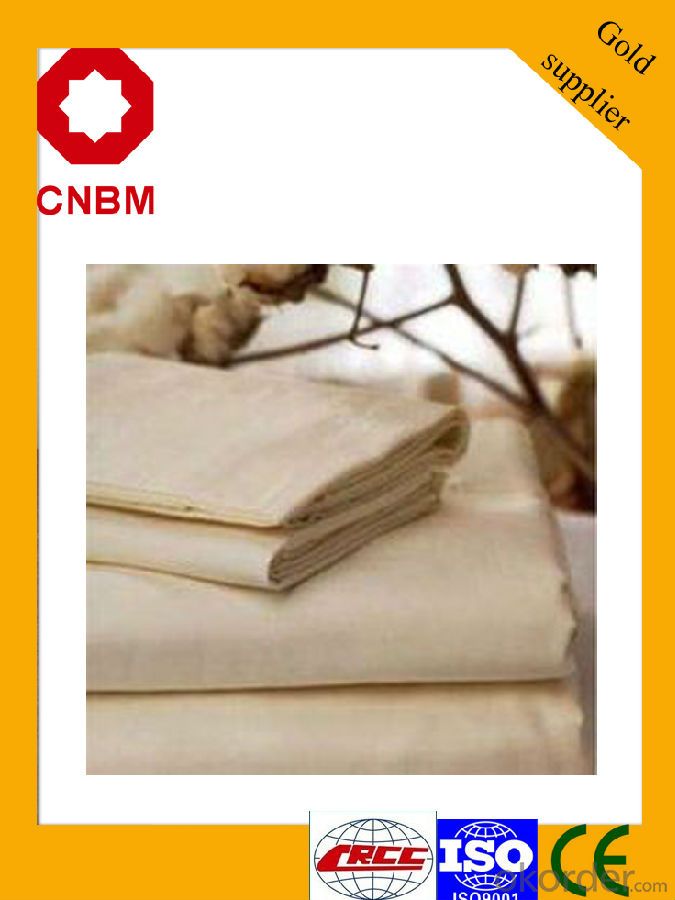
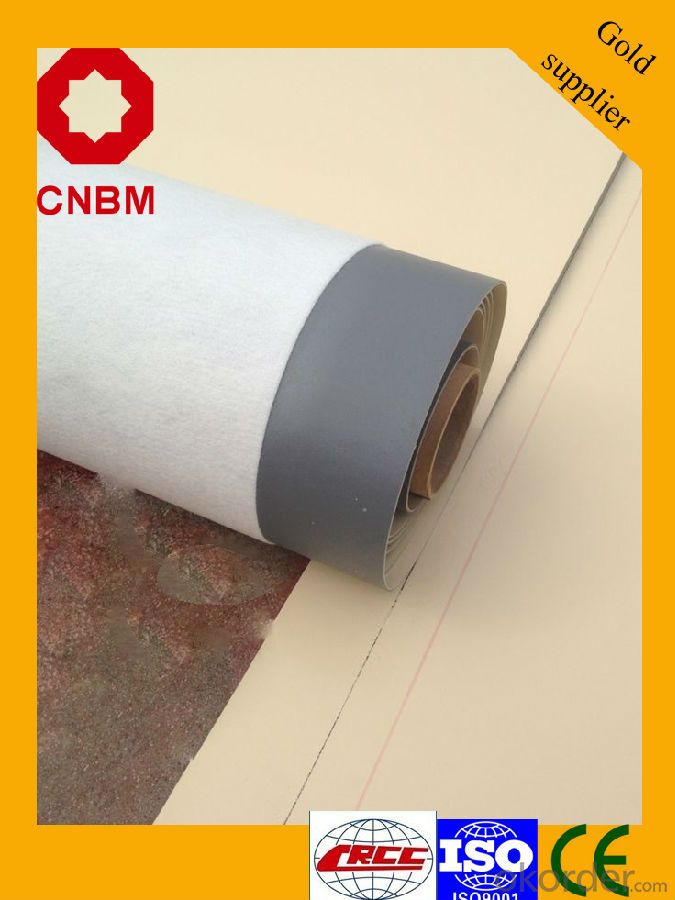
FAQ
Q: What's the de6abf1fe186f8d58506cbcfe46eed814d.jpglivery time ?
A: 3-5 days for 1-600 rolls, 10-15 days for container.
Q: What's the payment terms ?
A: TT/LC
Q: How do you make replacement with quality problems ?
A: New replacement will be packed into your next order or send to you directly after receive video or photo about quality problems.
- Q: Can a waterproofing membrane be used on both horizontal and vertical surfaces?
- Yes, a waterproofing membrane can be used on both horizontal and vertical surfaces. Waterproofing membranes are specifically designed to create a barrier against water infiltration, regardless of the orientation of the surface. These membranes are commonly used in various applications, such as roofs, foundations, basements, bathrooms, and swimming pools. They are typically made of materials like bitumen, rubberized asphalt, polyurethane, or PVC, which are highly resistant to water penetration. Whether it is a horizontal surface like a roof or a vertical surface like a wall, a waterproofing membrane can effectively prevent water from seeping through and causing damage. However, it is important to ensure that the membrane is properly installed and adhered to the surface to achieve optimal waterproofing performance.
- Q: Can a waterproofing membrane be used for a plaza deck waterproofing?
- Plaza deck waterproofing necessitates the use of a waterproofing membrane as they are consistently exposed to the elements, such as rain and snow. This is crucial in preventing water infiltration and potential harm to the underlying structure. Waterproofing membranes are specially designed to serve this purpose and safeguard the deck against moisture-related problems like leaks, deterioration, and mold formation. These membranes are typically constructed from materials like bitumen, PVC, or EPDM, and are applied in multiple layers to guarantee a strong and impermeable seal. By utilizing a waterproofing membrane, plaza decks can effectively preserve their structural integrity and longevity.
- Q: Does a waterproofing membrane add any additional insulation to a structure?
- No, a waterproofing membrane does not add any additional insulation to a structure. The primary purpose of a waterproofing membrane is to prevent water infiltration and protect the structure from moisture damage. It acts as a barrier against water penetration but does not provide any insulation value. Insulation, on the other hand, is designed to regulate heat flow and improve energy efficiency within a building. While both waterproofing and insulation are essential components in maintaining a well-functioning and energy-efficient structure, they serve different purposes and should be considered separately.
- Q: Can waterproofing membranes be used on underground structures?
- Indeed, underground structures can make use of waterproofing membranes. These membranes have been designed with the aim of creating a barrier against water infiltration and are widely utilized in various applications, including basements, tunnels, and underground parking lots. The main objective of employing waterproofing membranes in underground structures is to avert water penetration, as this can lead to structural damage and compromise stability. Generally, these membranes are crafted from materials like modified bitumen, PVC, EPDM, or HDPE, all of which possess outstanding water resistance properties. By applying waterproofing membranes correctly, a continuous and robust barrier is established, preventing water from seeping through the walls, floors, or foundations of underground structures. These membranes can be installed externally or, on occasion, as an integral part of the concrete walls or floors during construction. In addition to their water resistance capabilities, waterproofing membranes also offer protection against other elements such as chemicals, gases, and radon. They prove highly effective in preventing issues related to moisture, like the growth of mold, the deterioration of building materials, and structural damage, thus ensuring the durability and integrity of underground structures. It is crucial to bear in mind that the proper installation and maintenance of waterproofing membranes are of utmost importance for their effectiveness. It is advisable to engage the services of a qualified professional who can assess the specific requirements of the underground structure and recommend the appropriate type of waterproofing membrane and installation method. All in all, waterproofing membranes serve as a dependable and efficient solution for preventing water infiltration in underground structures, providing long-lasting protection and preserving the structural integrity of the building.
- Q: Can waterproofing membranes be used on rooftop terraces?
- Yes, waterproofing membranes can be used on rooftop terraces to protect them from water damage and ensure their longevity.
- Q: Can waterproofing membranes be used on loading docks?
- Indeed, loading docks can make use of waterproofing membranes. These membranes have been specifically crafted to create a shield against water infiltration, rendering them appropriate for a range of uses, including loading docks. The installation of waterproofing membranes on loading docks serves to thwart water damage and leakage into the underlying framework, thus safeguarding the dock's integrity and durability. Moreover, the utilization of waterproofing membranes can contribute to increased safety by minimizing the potential for accidents resulting from slippery surfaces on loading docks.
- Q: Can a waterproofing membrane be used for bridges and overpasses?
- Yes, a waterproofing membrane can be used for bridges and overpasses. Waterproofing membranes are commonly used in the construction industry to protect structures from water infiltration, including bridges and overpasses. These membranes are designed to create a barrier between the structure and moisture, preventing water from seeping into the concrete or steel components. By installing a waterproofing membrane, the lifespan of a bridge or overpass can be significantly extended, as it helps to prevent corrosion, concrete degradation, and other damages caused by water exposure. Additionally, waterproofing membranes can also provide protection against other environmental factors such as freeze-thaw cycles, chemicals, and UV radiation. Therefore, using a waterproofing membrane for bridges and overpasses is a common practice to enhance their durability and longevity.
- Q: Can waterproofing membranes be used on bridge decks?
- Bridge decks can benefit greatly from the application of waterproofing membranes. Due to the constant exposure to harsh weather conditions like rain, snow, and freeze-thaw cycles, the concrete and steel reinforcement of bridge decks can deteriorate. Waterproofing membranes are specifically designed to counter water infiltration and safeguard the bridge deck against damage caused by moisture. Typically composed of flexible materials like bitumen, PVC, or EPDM rubber, these membranes are directly applied to the surface of the bridge deck. Acting as a barrier, they prevent water from seeping into the concrete and causing corrosion of the reinforcement. They also help minimize crack formation and extend the lifespan of the bridge deck. Furthermore, the effectiveness and durability of waterproofing membranes can be enhanced by combining them with other protective coatings or systems. All in all, the utilization of waterproofing membranes on bridge decks is a widely employed and successful approach to ensure the long-term integrity and functionality of the structure.
- Q: Can waterproofing membranes be used on wood surfaces?
- Yes, waterproofing membranes can be used on wood surfaces. Waterproofing membranes are versatile products that can be applied to a variety of materials, including wood. They are designed to create a protective barrier that prevents water from penetrating the surface, thereby preventing damage caused by moisture, such as rotting, warping, or mold growth. When applied correctly, waterproofing membranes can effectively seal wood surfaces, making them resistant to water absorption and increasing their durability and lifespan. It is important to choose a waterproofing membrane that is specifically formulated for wood applications and follow the manufacturer's instructions for proper application and maintenance.
- Q: Does a waterproofing membrane require any specific primers or bonding agents for installation?
- For proper installation, a waterproofing membrane frequently necessitates specific primers or bonding agents. These primers or bonding agents are formulated to guarantee proper adhesion between the membrane and the substrate, ultimately enhancing the effectiveness and lifespan of the waterproofing system. The necessary type of primer or bonding agent may differ based on the specific materials used for the membrane and substrate. To ensure a successful installation, it is crucial to consult the manufacturer's guidelines or seek guidance from a waterproofing professional in order to determine the suitable primer or bonding agent for your particular project.
Send your message to us
SBS Waterproof Membrane, APP Waterproof Membrane, Asphalt Waterproof Membrane
- Loading Port:
- Shanghai
- Payment Terms:
- TT or LC
- Min Order Qty:
- 1000 m²
- Supply Capability:
- 200000 m²/month
OKorder Service Pledge
OKorder Financial Service
Similar products
Hot products
Hot Searches
Related keywords
